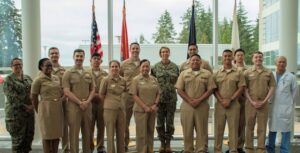
Story by Douglas Stutz
Naval Hospital Bremerton/Navy Medicine Readiness and Training Command Bremerton
It’s not too much of an imaginative stretch to envision a historical correlation between a military treatment facility and Navy Medicine’s more distinctive health care corps.
In the ensuing years following the end of the Second World War, Navy Medicine continued to transform staff and structure, as well as care for those in need.
Just as the naval hospital located on then Puget Sound Naval Shipyard was an amalgam of temporary buildings being converted and revamped into permanent wards to better care for patients, the battlefields of WWII which were defining frontlines for Navy medical officers, became the nascent foundation for a new staff corps dedicated to medical readiness.
Some of those medical officers were those who found themselves confronted with a host of clinical concerns such as preventing debilitating diseases like malaria, dengue fever and tuberculosis. Others took on the responsibility to ensure crucial coordination for scientific developments like improved trauma treatment and enhanced blood transfusions. There were also those with medical logistic expertise in the vanguard helping distribute penicillin to Sailors and Marines with bacterial infections.
The Navy realized that such dedicated groups was necessary to effectively and efficiently respond to the myriad healthcare issues.
On August 4, 1947, the Medical Service Corps came into being.
From the initial 251 who were placed into four specialty groups of allied sciences, optometry, pharmacy, and supply/administration, the corps has grown to approximately 2,700 active duty, with another 750 reserve officers.
There are approximately 25 MSC officers assigned to Naval Hospital Bremerton. Many gathered on the command’s quarterdeck to celebrate their birthday and honor their legacy with the traditional cake-cutting ceremony.
“I hope our cake is large enough for everyone here. But we’re Medical Service Corps! We’ll make it happen,” Capt. Maria Edusada, NHB director of administration quipped in her opening remarks. “As our MSC chief, I am humbled and honored to lead such an amazing group of officers. Not all our numbers could be here today due to providing care.”
“From the battlefields to the hospitals, from research labs to the frontlines of public health, MSC has always been at the forefront of advancing military medicine,” continued Edusada. “Our achievements are a testament to the hard work, resilience and dedication of each member of this extraordinary team. Our commitment and service have left an unprecedented mark on the history of the U.S. Navy and the care we provide.”
“It makes me proud to be part of the MSC. Providing support to ensure patient care is very rewarding to me,” shared Lt. j.g. David Tegtmeyer, NHB deputy chief information officer and operations management department head.
Tegtmeyer and others are proficient in 31 specialties which comprise three basic branches to handle all those many responsibilities throughout the many Navy Medicine hospitals, clinics and Navy fleet assets across the seven seas.
The Clinical Care specialties include audiology, clinical psychology, dietetics/food management, occupational therapy, optometry, pharmacy, physical therapy, physician assistant, podiatry, and social work.
The Health Care Science field encompasses aerospace experimental psychology, aerospace physiology, biochemistry, entomology, environmental health, industrial hygiene, medical technology, microbiology, physiology, radiation health, and research psychology.
Health Care Administration consists of education and training management, financial management, fleet marine force, general health care administration, health care facilities planning, information management, manpower systems analysis, medical logistics management, operations research, patient administration, and plans, operations and medical intelligence.
“Being part of the 77-year legacy of the Medical Service Corps is an honor. It means upholding a tradition of excellence, innovation, and dedication to service. I am proud to contribute to a legacy that has continuously evolved to meet the needs of the Navy and its personnel. I am committed to carrying that legacy forward,” exclaimed Ensign April M. White, NHB’s laboratory manager, division officer and master of ceremony for the birthday celebration.
Well-wishes were also shared from Rear Adm. Darin Via, U.S. Navy Surgeon General and Chief, Bureau of Medicine and Surgery and Rear Adm. Matthew Case, commander, Naval Medical Forces Atlantic, and chief, Medical Service Corps.
NMRTC Bremerton MSC officers also gathered for briefings on the state of their corps, as well as to discuss career planning.
“Looking ahead, we remain committed to our mission of providing the highest standard of medical care and support to our service members and their families,” stated Edusada. “With the same spirit of innovation and dedication that has guided us for the past 77 years, we will continue to push boundaries and set new standards in military medicine.”